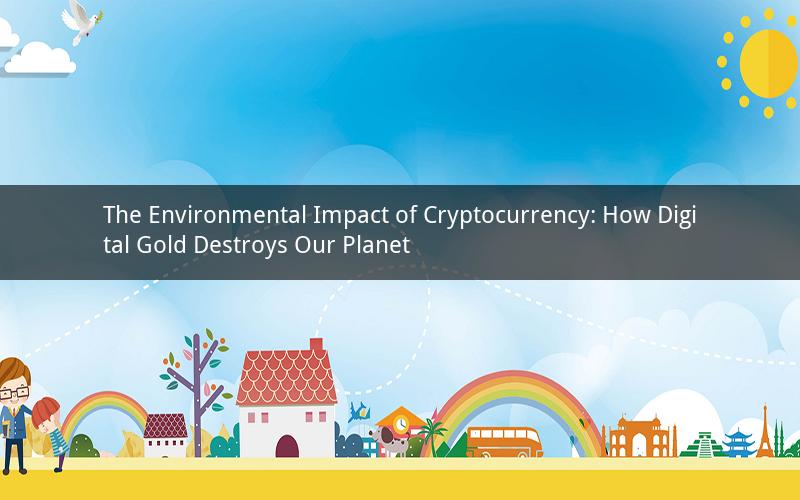
Introduction:
Cryptocurrency has revolutionized the financial industry, offering a decentralized and secure method of transaction. However, the environmental impact of mining cryptocurrencies has sparked a heated debate. This article delves into how cryptocurrency, often hailed as digital gold, is destroying our planet.
The Energy Consumption of Cryptocurrency Mining:
One of the primary concerns regarding cryptocurrency is its energy consumption. Mining cryptocurrencies requires vast amounts of electricity, leading to significant environmental damage. Here's an overview of the energy consumption associated with mining:
1. The Role of Miners:
Miners are responsible for verifying and adding new transactions to a blockchain network. To do this, they solve complex mathematical problems, which requires powerful computers and a substantial amount of energy.
2. The Increasing Energy Demand:
As the popularity of cryptocurrencies grows, so does the energy demand for mining. This has led to an exponential increase in electricity consumption, with some estimates suggesting that mining cryptocurrencies accounts for up to 2% of the world's total electricity usage.
3. The Environmental Impact:
The energy consumed by mining cryptocurrencies is primarily sourced from fossil fuels, such as coal, natural gas, and oil. These fuels emit greenhouse gases, contributing to climate change and air pollution.
The Carbon Footprint of Cryptocurrency Mining:
The carbon footprint of cryptocurrency mining is another critical concern. Here's an analysis of the carbon emissions associated with mining:
1. Greenhouse Gas Emissions:
Mining cryptocurrencies requires a substantial amount of electricity, which is often sourced from fossil fuels. This results in the release of greenhouse gases, such as carbon dioxide (CO2), methane (CH4), and nitrous oxide (N2O), into the atmosphere.
2. The Role of Geographical Location:
The carbon footprint of mining varies depending on the geographical location of the mining operation. Countries with a higher reliance on fossil fuels, such as China, have a larger carbon footprint due to their mining activities.
3. The Potential for Renewable Energy:
While the use of renewable energy sources, such as wind, solar, and hydroelectric power, can mitigate the carbon footprint of mining, the current infrastructure is not yet sufficient to support the massive energy demands of cryptocurrency mining.
The Impact on Renewable Energy Sources:
The increasing energy demand for cryptocurrency mining has raised concerns about the impact on renewable energy sources. Here's an analysis of the potential consequences:
1. Increased Demand for Energy:
The growing popularity of cryptocurrencies has led to a surge in energy consumption, which has put pressure on existing energy sources, including renewable energy.
2. The Risk of Overreliance on Fossil Fuels:
As the demand for energy continues to rise, there is a risk that countries may revert to fossil fuels to meet their energy needs, thus negating the benefits of renewable energy sources.
3. The Potential for Innovation:
Despite the challenges, the increasing demand for energy has also spurred innovation in renewable energy technologies, such as solar panels and wind turbines, which could potentially meet the energy demands of cryptocurrency mining.
Alternatives to Traditional Cryptocurrency Mining:
In light of the environmental concerns surrounding cryptocurrency mining, several alternative methods have been proposed. Here's an overview of these alternatives:
1. Proof of Stake (PoS):
Proof of Stake is a consensus mechanism that requires validators to hold and lock up a certain amount of cryptocurrency to participate in the network. This method consumes significantly less energy than traditional Proof of Work (PoW) mining.
2. Energy-Efficient Mining Hardware:
Developers are continuously working on energy-efficient mining hardware that consumes less electricity while maintaining the same level of computational power.
3. Green Mining:
Green mining refers to the use of renewable energy sources for mining cryptocurrencies. While still in its early stages, green mining has the potential to significantly reduce the environmental impact of cryptocurrency mining.
Conclusion:
The environmental impact of cryptocurrency mining is a pressing issue that requires immediate attention. As the popularity of cryptocurrencies continues to grow, it is crucial to find sustainable solutions that minimize the negative effects on our planet. By adopting alternative mining methods and promoting the use of renewable energy sources, we can pave the way for a greener and more sustainable future.
Questions and Answers:
1. What is the primary environmental concern regarding cryptocurrency mining?
The primary environmental concern is the significant energy consumption and subsequent greenhouse gas emissions associated with mining cryptocurrencies.
2. How does cryptocurrency mining contribute to climate change?
Cryptocurrency mining consumes vast amounts of electricity, often sourced from fossil fuels. This leads to the release of greenhouse gases, such as carbon dioxide, which contribute to climate change.
3. Can renewable energy sources mitigate the environmental impact of cryptocurrency mining?
Yes, the use of renewable energy sources, such as wind, solar, and hydroelectric power, can help reduce the environmental impact of cryptocurrency mining. However, the current infrastructure is not yet sufficient to support the massive energy demands of mining.
4. What are some alternative methods to traditional cryptocurrency mining?
Some alternative methods include Proof of Stake (PoS), energy-efficient mining hardware, and green mining, which utilizes renewable energy sources.
5. How can we promote the adoption of sustainable cryptocurrency mining practices?
We can promote sustainable cryptocurrency mining practices by encouraging the use of renewable energy sources, implementing energy-efficient mining hardware, and supporting alternative consensus mechanisms like Proof of Stake. Additionally, raising awareness about the environmental impact of mining and advocating for regulatory measures can help drive change in the industry.